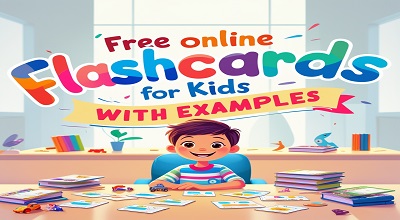Free Online Flashcards for Kids
Free Online Flashcards for Kids: Learning tools have evolved significantly in today’s digital age, making education more interactive and accessible. One such effective tool is online flashcards, which help children enhance their memory, vocabulary, and cognitive skills.
This comprehensive guide explores the best free online flashcards for kids, complete with examples, benefits, and how to use them effectively. Whether you’re a parent, teacher, or student, this article will provide valuable insights into leveraging free digital flashcards for improved learning experiences.
Why Use Online Flashcards for Kids?
Flashcards have been a staple in education for decades, but online flashcards offer additional advantages:
- Interactive Learning – Animated and engaging content keeps kids interested.
- Accessibility – Available anytime, anywhere with an internet connection.
- Customizable – Parents and teachers can create personalized flashcards.
- Cost-Effective – Free resources reduce the need for physical cards.
- Multimedia Support – Images, audio, and videos enhance retention.
Top Free Online Flashcard Platforms for Kids
Here are some of the best free online flashcard websites and apps for children:
1. Quizlet
Features:
- Pre-made flashcards on various subjects.
- Games and quizzes for interactive learning.
- Audio pronunciations for language learning.
Example:
- Topic: Animal Names
- Front: Image of a lion
- Back: “Lion – A large wild cat.”
2. Anki
Features:
- Spaced repetition for better memory retention.
- Supports multimedia (images, sounds, videos).
- Customizable decks for personalized learning.
Example:
- Topic: Math Multiplication
- Front: “7 × 8 = ?”
- Back: “56”
3. Cram
Features:
- Thousands of pre-made flashcard sets.
- Study modes like memorize, test, and games.
- Mobile-friendly for on-the-go learning.
Example:
- Topic: Solar System
- Front: “Which planet is known as the Red Planet?”
- Back: “Mars”
4. Brainscape
Features:
- Adaptive learning algorithm.
- Collaborative flashcard creation.
- Ideal for advanced subjects.
Example:
- Topic: World Capitals
- Front: “What is the capital of Japan?”
- Back: “Tokyo”
5. Tinycards by Duolingo
Features:
- Fun, game-like interface.
- Focuses on vocabulary and languages.
- Bite-sized lessons for quick learning.
Example:
- Topic: Spanish Basics
- Front: “Hello”
- Back: “Hola”
How to Create Effective Flashcards for Kids?
To maximize learning, follow these flashcard creation tips:
- Keep It Simple – Use clear, concise wording.
- Use Visuals – Images help with memory retention.
- Add Audio – Great for language pronunciation.
- Incorporate Games – Turn learning into a fun activity.
- Review Regularly – Spaced repetition improves recall.
Examples of Flashcards for Different Subjects
1. Alphabet Flashcards
- Front: “A” with an apple image
- Back: “A is for Apple”
2. Math Flashcards
- Front: “5 + 3 = ?”
- Back: “8”
3. Science Flashcards
- Front: “What gas do plants absorb?”
- Back: “Carbon Dioxide (CO₂)”
4. History Flashcards
- Front: “Who was the first President of the USA?”
- Back: “George Washington”
5. Language Flashcards
- Front: “Bonjour” (French)
- Back: “Hello” (English)
Benefits of Using Online Flashcards
- Improves Memory Retention – Active recall strengthens learning.
- Engages Multiple Senses – Visual and auditory stimuli enhance understanding.
- Self-Paced Learning – Kids can learn at their own speed.
- Track Progress – Digital platforms provide analytics.
- Eco-Friendly – Reduces paper waste.
FAQs About Free Online Flashcards for Kids
1. Are online flashcards really free?
Yes! Many platforms like Quizlet, Cram, and Tinycards offer free versions with extensive features. Some may have premium upgrades, but the free options are highly effective.
2. What age group benefits most from flashcards?
Flashcards work for all ages, but they are especially useful for kids aged 3-12 for foundational learning.
3. Can I create my own flashcards?
Absolutely! Most platforms allow custom flashcard creation with text, images, and audio.
4. How often should kids use flashcards?
For best results, 5-10 minutes daily is ideal. Spaced repetition (reviewing over time) boosts long-term retention.
5. Are online flashcards safe for kids?
Most reputable platforms have child-friendly content, but parental supervision is recommended to ensure appropriate material.
Conclusion
Free online flashcards for kids are a powerful, engaging, and cost-effective way to enhance learning. With platforms like Quizlet, Anki, and Tinycards, children can explore various subjects interactively.
By incorporating visuals, audio, and games, parents and teachers can make learning fun and effective. Start using these free digital flashcards today and watch your child’s knowledge grow!
Free Download: Real Racing 3 MOD APK
